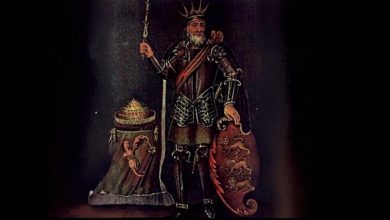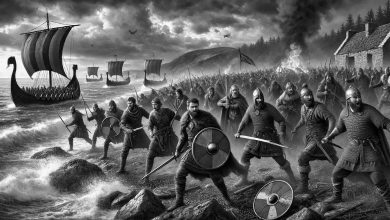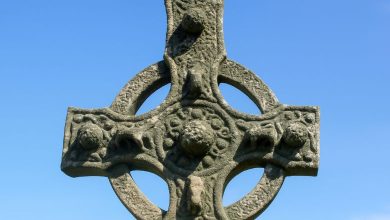Patron Saints of the UK: Exploring the Noble Guardians

Patron saints have been an important part of UK culture and religion for a long time. Every country, including Scotland, Wales, England, and Ireland, has its own venerated saints who represent the culture, values, and religion of its citizens. A majority in these countries follow Christianity. That’s why many people in these countries still honor their saints. The lives of these outstanding guardians are tales of bravery, generosity, and faith. In this article, we will discuss the most famous patron saints who are still revered in all countries.
Table of Contents
ToggleWho Are Saints?
Saints are holy personalities who achieved recognition for their exceptional holiness, morality, and dedication to their faith. Churches proclaim them as saints because of what they did for their people. They believe patrons to be the protectors and spiritual models for nations and cultures. Patron saints serve as ideal and distinctive guardians of certain places, institutions, or causes.
To preserve religious devotion and cultural identity for future generations, patron saints are still remembered in the form of festivals and religious customs. It may surprise you to learn that the United Kingdom has a large number of saints. While some of them have been forgotten, most are still recalled. This guide will cover the most notable patrons of each UK nation. Turning our attention to Scotland’s religious figures.
Patron Saints of Scotland
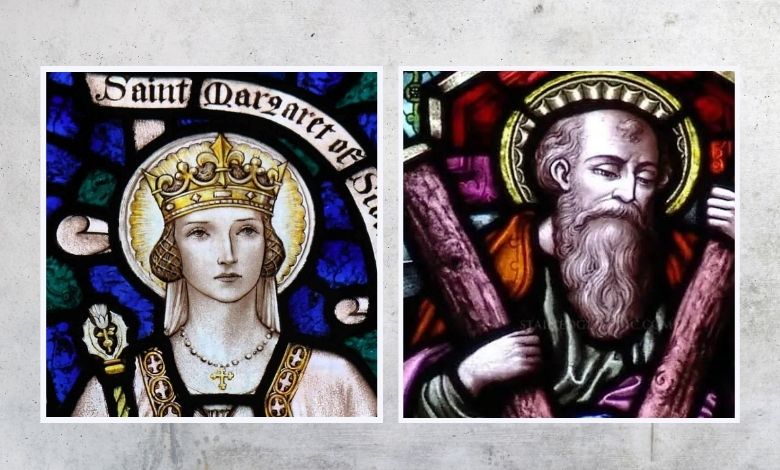
The exact number of Scottish saints is uncertain, but sources claim almost 750 holy peoples have this title. They reflect Scotland’s deep-rooted faith and cultural strength. The most popular and widely celebrated patrons are Saint Andrew and Saint Margaret. They hugely inspired generations and influenced Scotland’s religious traditions via their lives of bravery, kindness, and dedication.
Saint Andrew
Saint Andrew was one of Jesus’ twelve apostles. Scots still remember him for his devotion and humility. Like Jesus Christ, he was crucified on an X-shaped cross. This cross is Saltire and a proud part of the Scottish flag. The legacy of Saint Andrew stands for protection, faith, and patriotism. The day of Saint Andrew is celebrated on the 30th of November as a feast day. Therefore, Scots celebrate his day wearing St. Andrew Tartan kilts to admire him.
Saint Margaret of Scotland
Many people consider only men to be patron saints while Queen Saint Margaret of Scotland challenges the misconception that only men can be saints. She served as a queen from 1070 to 1093. Her efforts in charitable work, strong religious convictions, and church reforms inspired people at the time. Her struggles for the betterment of people and enhanced religious instruction had a long-lasting effect on Scottish culture and spirituality.
Patron Saints of Wales

Wales also commemorates its patron saints to express a powerful sense of religious belief, cultural pride, and national identity. Saint David is the only patron saint in Wales while the number of saints there is approximately 800. The lives of these heroes represent healing and steadfast adherence to Christianity.
Saint David
Saint David was a sixth-century bishop, who had many miracles. His miracles and dedication to Christianity made him a patron saint. He established monk communities emphasizing charity, prayer, and humble living. Many miracles are associated with him while the rise of the earth beneath him as he spoke, is a representation of God’s grace. Daffodils are associated with Saint David and are worn on his feast day to honor him on 1st March. Wearing traditional attire is also a common practice and the most suitable option for this event is St David Tartan Kilt. If women want to wear a kilt, brands like Irish Kilt Shop have Ladies St. David’s Tartan Kilts.
Saint Winefride
Saint Winifred was a Welsh virgin martyr from the 7th century. She became a nun and spread Christianity in her surroundings. Her followers started praising her in the early 8th century, but her biography was first documented in England in the 12th century. A well is associated with her in Holywell, Wales, which still is a destination for pilgrims for more than thirteen centuries. Commemorations still take place there on November 3rd, as her feast day and other religious services and festivities.
Patron Saints of England
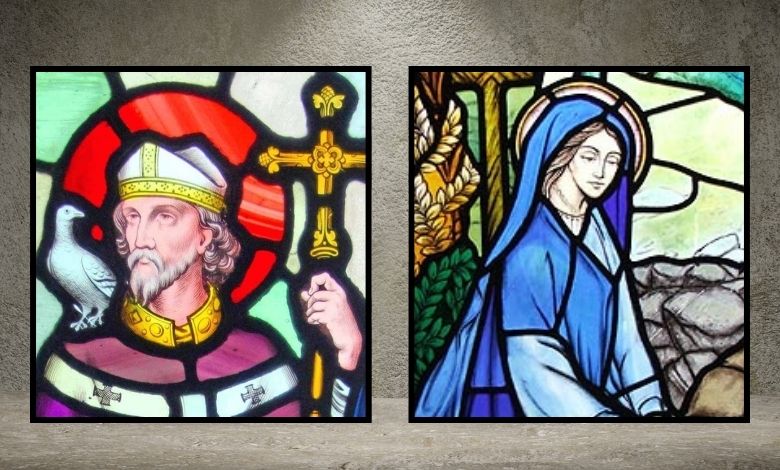
Let’s talk about the patron saint of England. Since Christianity is the dominant religion in England, many people honor its patron saints. The exact number of saints is uncertain there while this country only has Saint George as patron saint.
Saint George
Saint George was a martyr of England who sacrificed himself for Christian belief and refused to bow his knees to pagan gods. He served as a knight and saint in the Roman army who is believed to have slain a dragon. As he was a knight, English people considered him a symbol of bravery. The 23rd of April is the day that people connect to him and commemorate as a feast event. Moreover, Saint George parades and other cultural events are also celebrated to make the day more memorable.
Saint Alban
Saint Alban is the British protomartyr because he was the first British Christian martyr. History claims that Alban was a Roman residing in Verulamium. He provided sanctuary to a Christian priest and later adopted Christianity. The Roman emperor beheaded him on a hilltop above the Roman town of Verulamium. People visit his place of martyrdom on June 22nd. A Church was built there that people started visiting as pilgrims later.
Patron Saints of Ireland
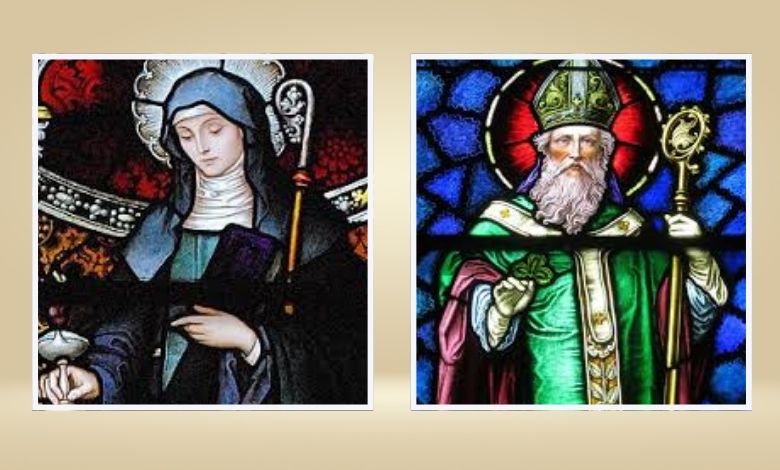
Ireland falls among the most beautiful countries worldwide. Ireland attracts many visitors each year. Stunning landscapes, rich culture, and welcoming people provide it with a unique identity. patron saints have played a major role in shaping Irish values and spirituality. The number of saints is quite significant while they admire 3 patron saints: Saint Patrick, Brigid, and Columba.
Saint Patrick
Saint Patrick is the patron saint of Ireland, who became a Christian missionary in the 5th century. He was born in Roman Britain. Irish invaders kidnapped him at a very young age and sold into slavery. After a few years, he succeeded in escaping and returned to Ireland and worked as an apostle to bring Christianity to his country. He used shamrock (three-leafed clover) which is now the national plant of Ireland, for explaining the Holy Trinity.
His day is March 17, which is also martyrdom day. People honor his legacy on this day by performing religious services, parades, and other cultural events. They usually dress up in particular Saint Patrick Tartan kilts.
Saint Brigid of Kildare
Saint Brigid of Kildare was an Irish nun from the fifth century who is a respectful part of history to current date. Irish people still admire her for her strength of character, for feeding the poor, and for her profound compassion. She lived during a time when pagans were transitioning into Christianity.
Her passion for helping less fortunate people, healing the ill, and defending the weak made her the most respectful woman in the Christian community. To this day, she is a symbol of spirit, kindness, and wisdom. Irish people celebrate her day on the 1st of February which is also the day of her death.
Cultural and Religious Impact
Patron saints have a big impact on both religious and cultural activities in the UK. Their influence is possible to witness in national identity, iconography, and cultural customs. As a result, people commemorate these saints with a variety of traditions and festivities. Many religious customs and feasts customarily occur on the patron saints’ celebrations. These days are not public holidays but people mark them with differing levels of religious importance.
Regarding the cultural impact, in Scotland and Wales in particular, Patron saint days are often marked by cultural festivals including parades, concerts, and historical events. To remember their lives and virtues, saints’ stories and symbols are important parts of their literature, art, and architecture.
Heritage Dress for Saint’s Day Celebrations
There are no strict rules for dressing in the UK. The celebrations of these days happen as cultural events, people prefer wearing traditional attire, thanks to the Highlander community spread all around the UK. No matter which patron saint you follow, you will see people wearing traditional dress and tartan kilts as the top priority. To make things easier for kilt-wearing communities, some brands have specified kilts to these saints to celebrate heritage in cultural ways.
Celebrate Heritage with Irish Kilt Shop
We just mentioned some kilt-making brands helping to admire culture in traditional ways. You must be thinking about those brands. Let’s help you to fulfill your kilt outfit requirements with Irish Kilt Shop. We are an Irish-based, online store serving the kilt-wearing community in the UK. At Irish Kilt Shop, we offer customized kilts for every celebration regardless of your patterns. We have every pattern. Whether you’re preparing for one of these or another celebration, do not wait, explore our collection, and order one for yourself!


